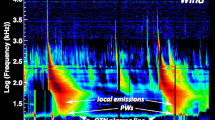Abstract
A highly anisotropic packet of solar electron intensities was observed on 6 April 1971 with a sensitive electrostatic analyzer array on the Earth-orbiting satellite IMP-6. The anisotropies of intensities at electron energies of several keV were factors ≳ 10 favoring the expected direction of the interplanetary magnetic lines of force from the Sun. The directional, differential intensities of solar electrons were determined over the energy range 1–40 keV and peak intensities were ∼ 102 cm−2 s−1 sr−1 eV−1 at 2–6 keV. This anisotropic packet of solar electrons was detected at the sattelite for a period of 4200 s and was soon followed by isotropic intensities for a relatively prolonged period. This impulsive emission was associated with the onsets of an optical flare, soft X-ray emission and a radio noise storm at centimeter wavelengths on the western limb of the Sun. Simultaneous measurements of a type III radio noise burst at kilometric wavelengths with a plasma wave instrument on the same satellite showed that the onsets for detectable noise levels ranged from 500 s at 178 kHz to 2700 s at 31.1 kHz. The corresponding drift rate requires a speed of ∼ 0.15c for the exciting particles if the emission is at the electron plasma frequency. The corresponding electron energy of ∼ 6 keV is in excellent agreement with the above direct observations of the anisotropic electron packet. Further supporting evidence that several-keV solar electrons in the anisotropic packet are associated with the emission of type III radio noise beyond ∼ 50R ⊙ is provided by their time-of-arrival at Earth and the relative durations of the radio noise and the solar electron packet. Electron intensities at E ≳ 45 keV and the isotropic intensities of lower-energy solar electrons are relatively uncorrelated with the measurements of type III radio noise at these low frequencies. The implications of these observations relative to those at higher frequencies, and heliocentric radial distances ≲ 50R ⊙, include apparent deceleration of the exciting electron beam with increasing heliocentric radial distance.
Similar content being viewed by others
References
Anderson, K. A. and Lin, R. P.: 1966, Phys. Rev. Letters 16, 1121.
Anderson, K. A. and Lin, R. P.: 1969, J. Geophys. Res. 74, 3953.
Anderson, K. A., Chase, L. M., Lin, R. P., McCoy, J. E., and McGuire, R. E.: 1971, Univ. of California (Berkeley) Res. Rep. 12 (73).
Drake, J. F.: 1971, Solar Phys. 16, 152.
Fainberg, J. and Stone, R. G.: 1970, Solar Phys. 15, 433.
Fainberg, J. and Stone, R. G.: 1971a, Astrophys. J. 164, L123.
Fainberg, J. and Stone, R. G.: 1971b, Solar Phys. 17, 392.
Frank, L. A.: 1967, J. Geophys. Res. 72, 185.
Frank, L. A., Henderson, N. K., and Swisher, R. L.: 1969, Rev. Sci. Instr. 40, 685.
Fredricks, R. W., Scarf, F. L., and Frank, L. A.: 1971, J. Geophys. Res. 76, 6691.
Gintsburg, V. L. and Zheleznyakov, V. V.:1958, Soviet Astron. 2, 653.
Hartz, T. R.: 1969, Planetary Space Sci. 17, 267.
Kundu, M. R.: 1965, Solar Radio Astronomy, Interscience Publishers, New York.
Lin, R. P.: 1970, Solar Phys. 12, 266.
Lin, R. P. and Hudson, H. S.: 1971, Solar Phys. 17, 412.
Malville, J. M.: 1962, Astrophys. J. 136, 266.
Montgomery, M. D., Bame, S. J., and Hundhausen, A. J.: 1968, J. Geophys. Res. 73, 4999. NOAA Solar-Geophysical Data, No. 326, Part II, October 1971.
Newkirk, G.: 1961, Astrophys. J. 133, 983.
Ogilvie, K. W., Scudder, J. D., and Sugiura, M.: 1971, J. Geophys. Res. 76, 8165.
Scarf, F. L., Fredricks, R. W., Frank, L. A., and Neugebauer, M.: 1971, J. Geophys. Res. 76, 5162.
Sturrock, P. A.: 1961, Nature 192, 58.
Tidman, D. A., Birmingham, T. J., and Stainer, H. M.: 1966, Astrophys. J. 146, 207.
Van Allen, J. A.: 1970, J. Geophys. Res. 75, 29.
Van Allen, J. A. and Krimigis, S. M.: 1965, J. Geophys. Res. 70, 5737.
Wild, J. P.: 1950, Australian J. Sci. Res. A3, 541.
Wild, J. P., Murray, J. D., and Rowe, W. C.: 1954, Australian J. Phys. 7, 439.
Wild, J. P., Sheridan, K. V., and Neylan, A. A.: 1959, Australian J. Phys. 12, 369.
Author information
Authors and Affiliations
Additional information
Research supported in part by the National Aeronautics and Space Administration under contracts NAS5-11039 and NAS5-11074 and grant NGL16-001-002 and by the Office of Naval Research under contract N000-14-68-A-0196-0003.
Rights and permissions
About this article
Cite this article
Frank, L.A., Gurnett, D.A. Direct observations of low-energy solar electrons associated with a type III solar radio burst. Sol Phys 27, 446–465 (1972). https://doi.org/10.1007/BF00153116
Received:
Revised:
Issue Date:
DOI: https://doi.org/10.1007/BF00153116




